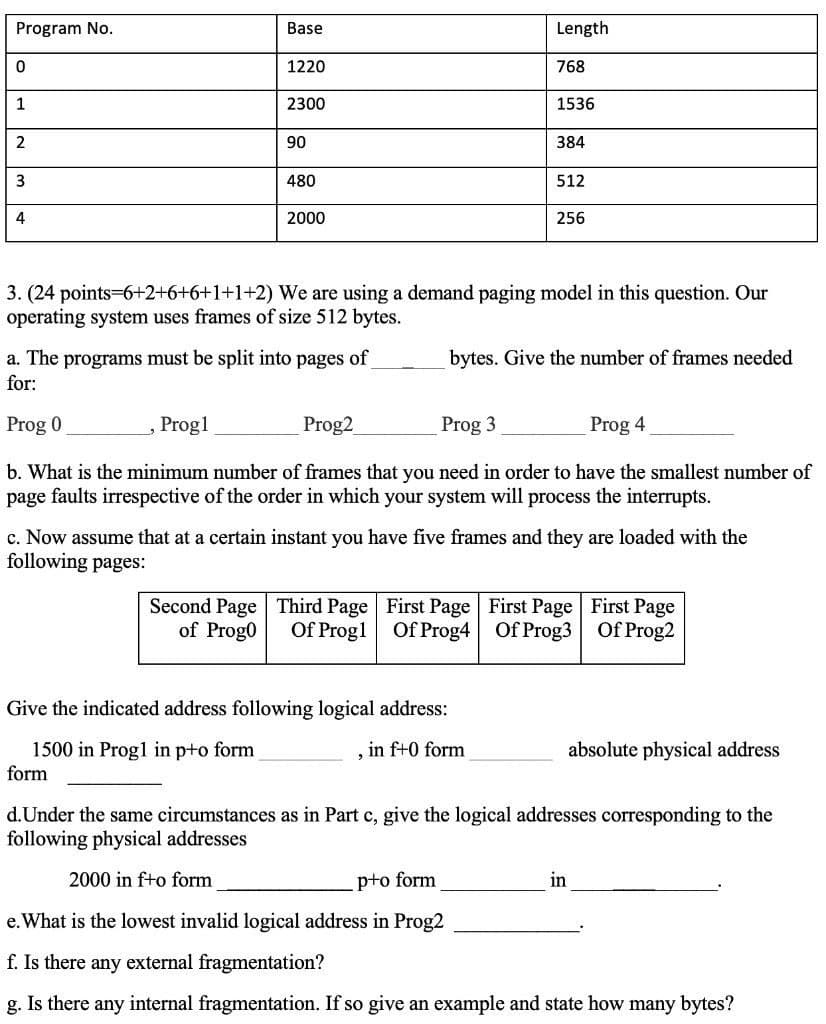Program No. 0 1 2 3 4 Base 1220 2300 90 Second Page of Progo form 480 3. (24 points=6+2+6+6+1+1+2) operating system uses frames of size 512 bytes. 2000 a. The programs must be split into pages of for: Prog 0 We are using a demand paging model in this question. Our Length 768 1536 384 512 Progl Prog2 Prog 3 Prog 4 b. What is the minimum number of frames that you need in order to have the smallest number o page faults irrespective of the order in which your system will process the interrupts. 256 bytes. Give the number of frames needed c. Now assume that at a certain instant you have five frames and they are loaded with the following pages: Third Page First Page Of Progl Of Prog4 Give the indicated address following logical address: 1500 in Progl in pto form , in f+0 form First Page Of Prog3 First Page Of Prog2 in absolute physical address d. Under the same circumstances as in Part c, give the logical addresses corresponding to the following physical addresses 2000 in fto form p+o form e. What is the lowest invalid logical address in Prog2 f. Is there any external fragmentation? g. Is there any internal fragmentation. If so give an example and state how many bytes?
Program No. 0 1 2 3 4 Base 1220 2300 90 Second Page of Progo form 480 3. (24 points=6+2+6+6+1+1+2) operating system uses frames of size 512 bytes. 2000 a. The programs must be split into pages of for: Prog 0 We are using a demand paging model in this question. Our Length 768 1536 384 512 Progl Prog2 Prog 3 Prog 4 b. What is the minimum number of frames that you need in order to have the smallest number o page faults irrespective of the order in which your system will process the interrupts. 256 bytes. Give the number of frames needed c. Now assume that at a certain instant you have five frames and they are loaded with the following pages: Third Page First Page Of Progl Of Prog4 Give the indicated address following logical address: 1500 in Progl in pto form , in f+0 form First Page Of Prog3 First Page Of Prog2 in absolute physical address d. Under the same circumstances as in Part c, give the logical addresses corresponding to the following physical addresses 2000 in fto form p+o form e. What is the lowest invalid logical address in Prog2 f. Is there any external fragmentation? g. Is there any internal fragmentation. If so give an example and state how many bytes?
Computer Networking: A Top-Down Approach (7th Edition)
7th Edition
ISBN:9780133594140
Author:James Kurose, Keith Ross
Publisher:James Kurose, Keith Ross
Chapter1: Computer Networks And The Internet
Section: Chapter Questions
Problem R1RQ: What is the difference between a host and an end system? List several different types of end...
Related questions
Question

Transcribed Image Text:Program No.
0
1
2
3
4
Base
1220
2300
Second Page
of Progo
form
90
480
3. (24 points=6+2+6+6+1+1+2)
operating system uses frames of size 512 bytes.
2000
Length
768
1536
Third Page First Page
Of Progl Of Prog4
Give the indicated address following logical address:
1500 in Progl in p+o form
in f+0 form
384
We are using a demand paging model in this question. Our
512
a. The programs must be split into pages of
for:
Prog 0
Progl
Prog2
Prog 3
Prog 4
b. What is the minimum number of frames that you need in order to have the smallest number of
page faults irrespective of the order in which your system will process the interrupts.
256
bytes. Give the number of frames needed
c. Now assume that at a certain instant you have five frames and they are loaded with the
following pages:
First Page
Of Prog3
First Page
Of Prog2
in
absolute physical address
d. Under the same circumstances as in Part c, give the logical addresses corresponding to the
following physical addresses
2000 in fto form
p+o form
e. What is the lowest invalid logical address in Prog2
f. Is there any external fragmentation?
g. Is there any internal fragmentation. If so give an example and state how many bytes?
Expert Solution
This question has been solved!
Explore an expertly crafted, step-by-step solution for a thorough understanding of key concepts.
Step by step
Solved in 2 steps with 2 images

Recommended textbooks for you

Computer Networking: A Top-Down Approach (7th Edi…
Computer Engineering
ISBN:
9780133594140
Author:
James Kurose, Keith Ross
Publisher:
PEARSON

Computer Organization and Design MIPS Edition, Fi…
Computer Engineering
ISBN:
9780124077263
Author:
David A. Patterson, John L. Hennessy
Publisher:
Elsevier Science

Network+ Guide to Networks (MindTap Course List)
Computer Engineering
ISBN:
9781337569330
Author:
Jill West, Tamara Dean, Jean Andrews
Publisher:
Cengage Learning

Computer Networking: A Top-Down Approach (7th Edi…
Computer Engineering
ISBN:
9780133594140
Author:
James Kurose, Keith Ross
Publisher:
PEARSON

Computer Organization and Design MIPS Edition, Fi…
Computer Engineering
ISBN:
9780124077263
Author:
David A. Patterson, John L. Hennessy
Publisher:
Elsevier Science

Network+ Guide to Networks (MindTap Course List)
Computer Engineering
ISBN:
9781337569330
Author:
Jill West, Tamara Dean, Jean Andrews
Publisher:
Cengage Learning

Concepts of Database Management
Computer Engineering
ISBN:
9781337093422
Author:
Joy L. Starks, Philip J. Pratt, Mary Z. Last
Publisher:
Cengage Learning

Prelude to Programming
Computer Engineering
ISBN:
9780133750423
Author:
VENIT, Stewart
Publisher:
Pearson Education

Sc Business Data Communications and Networking, T…
Computer Engineering
ISBN:
9781119368830
Author:
FITZGERALD
Publisher:
WILEY